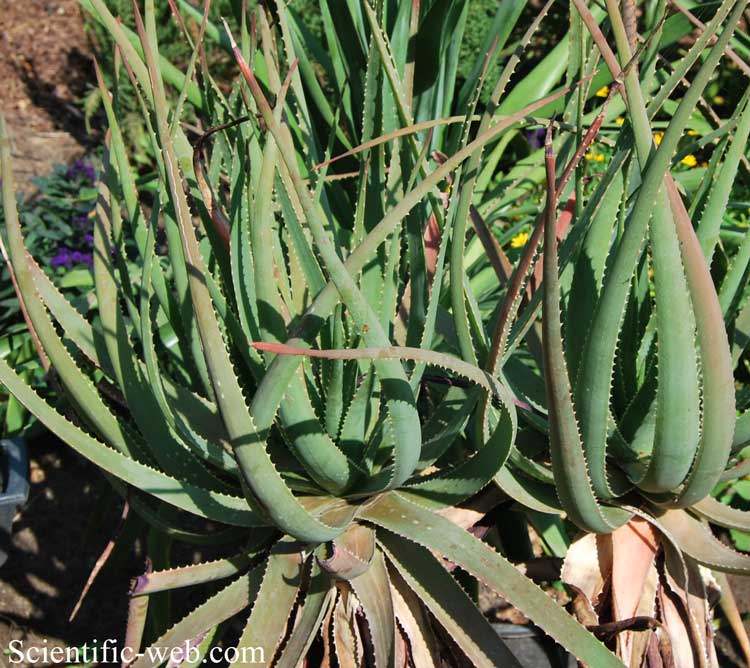
Aloe succotrina, Photo: Michael Lahanas
Classification System: APG IV
Superregnum: Eukaryota
Regnum: Plantae
Cladus: Angiosperms
Cladus: Monocots
Ordo: Asparagales
Familia: Asphodelaceae
Subfamilia: Asphodeloideae
Genus: Aloe
Species: Aloe rivae
Name
Aloe rivae Baker in D.Oliver & auct. suc. (eds.), Fl. Trop. Afr. 7: 465 (1898).
Distribution
Native distribution areas:
Continental: Africa
Regional: Eastern Africa
S. Ethiopia to N. Kenya
References: Brummitt, R.K. 2001. TDWG – World Geographical Scheme for Recording Plant Distributions, 2nd Edition
References
Baker, J.G. in D.Oliver & auct. suc. (eds.), 1898. Fl. Trop. Afr. 7: 465
Links
Govaerts, R. et al. 2019. Aloe rivae in World Checklist of Selected Plant Families. The Board of Trustees of the Royal Botanic Gardens, Kew. Published online. Accessed: 2019 Feb. 19. Reference page.
International Plant Names Index. 2019. Aloe rivae. Published online. Accessed: Feb. 19 2019.
The Plant List 2013. Aloe rivae in The Plant List Version 1.1. Published online. Accessed: 2019 Feb. 19.
Tropicos.org 2019. Aloe rivae. Missouri Botanical Garden. Published online. Accessed: 19 Feb. 2019.
Vernacular names
Aloe succotrina, the Fynbos aloe, is an aloe which is endemic to Cape Town and the south-western corner of the Western Cape, South Africa.
Distribution
Aloe succotrina is naturally found on the Cape Peninsula, and as far as Mossel Bay to the east. This aloe is common in Peninsula Sandstone Fynbos vegetation, and typically grows high up on cliff faces and rocky outcrops where seasonal fires do not reach it. It is one of the few Aloes that naturally occur in fynbos habitats - along with the Fan Aloe and Aloiampelos commixta of Table Mountain.
It is one of only three aloes and their relatives, with Aloiampelos commixta and Aloe maculata, that are indigenous to the city of Cape Town.
Description
Aloe succotrina in 1887 botanical illustration from Köhler's Medicinal Plants.
The Aloe succotrina plant forms clusters of between 1–2 metres (3.3–6.6 ft) diameter, with its leaves forming dense rosettes. In winter when it flowers (June to September) it produces a tall raceme, bearing shiny red flowers that are pollinated by sunbirds.
Taxonomically, it forms part of the Purpurascentes series of very closely related Aloe species, together with Aloe microstigma, Aloe gariepensis, Aloe khamiesensis and Aloe framesii.[1]
Cultivation and Uses
Aloe succotrina can easily be grown as an ornamental plant in Mediterranean climate gardens, rockeries, and in containers. It is particularly striking in winter, when it flowers. Western Cape gardens use it in Fynbos native plant themed natural landscaping. The plant prefers a sunny, well drained spot. Space should be provided for maturity, as it eventually grows into a large and dense cluster.
The Fynbos aloe can be propagated both by cuttings/offshoots or by seed.
This species has uses as a medicinal plant.[2]
See also
Biodiversity of Cape Town
Cape Floristic Region
Index: Fynbos - habitats and species.
Table Mountain
Table Mountain National Park
References
Reynolds, G.W. 1950. The aloes of Southern Africa. Balkema, Cape Town.
Köhler, Franz Eugen (1887) Köhler's Medicinal Plants
Retrieved from "http://en.wikipedia.org/"
All text is available under the terms of the GNU Free Documentation License

